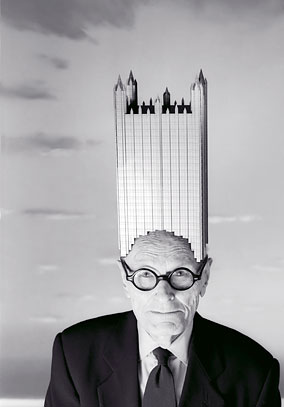. . . should not throw stones. In 1949, the architect Philip Johnson built a glass house in New Caanan, Connecticut. This house was so far ahead of it’s time that it is still shockingly modern today. I recently had the opportunity to visit this house on the occasion of a milestone birthday (we won’t say which one). I have had a yen to see Johnson’s Glass House since it was donated to The National Historic Preservation Trust in 2007. It is now open to the public for very small groups to tour.
The Glass House immediately captures your imagination with its glass walls on all sides and no interior walls, save a small brick silo in the interior which houses the bathroom. There are no curtains on the windows. Luckily, the house sits on forty five acres with a high stone wall that wards off prying eyes. Your natural reaction when visiting historic houses is to imagine yourself living in the house. One guest was obviously ruminating on this idea when she exclaimed, “Well, it may be very beautiful, but I certainly couldn’t live here.” Philip Johnson replied, “I haven’t ask you to, madam.”
An architect known for his many smart one liners, Philip Johnson was a cultivator of self promotion and sound bites long before they became de rigeur. He called Frank Lloyd Wright, “the greatest architect of the eighteenth century.” Phillip was also an enigma.
For a time before World War II and the full horrors of the Nazis were known, he was an admirer of Hitler. It may have been the extreme order and the hyper-masculine uniforms that drew him in. This, while he was carrying on an intimate relationship with Jimmie Daniels, a black night club owner/entertainer in Harlem. As a kind of atonement for his flirtation with fascism, he later designed a synagogue in Port Chester, New York for no fee.
Many of Philip Johnson’s buildings were quite controversial when originally built. The new addition to the Boston Public Library was called a “mausoleum.” The Crystal Cathedral in Garden Grove, California was dubbed, “a holy intersection of business, commerce, art and religion, in that order.” The pediment atop the AT&T building in New York City was likened to a “chippendale bookcase.”
Even with all of Philip Johnson’s foibles, both in his personal and professional lives, he did make a major mark on modern architecture and art. He was responsible for introducing Andy Warhol and Mark Rothko to the Museum of Modern Art, of which he was also a board member. His way-ahead-of-his-time architectural designs were cutting edge and some have stood the test of time, the true measure of an architect’s work.
The Glass House was his own personal retreat. He used it to bring people together from the world of art and architecture to discuss ideas. Scattered on his forty-five acres are other buildings designed by him, including an art gallery with an ingeniously designed system to house and display art work, a guest house, an office, a building for sculpture display, a Greek temple folly by a pond, and a structure that was designed after a Frank Stella sculpture dubbed “the monstah.”
All of them pale to the glass house in purity of design and visual beauty. Even though some of the buildings on the forty-five acres are almost Dr. Suess cartoonish in nature, the property showcases his widely divergent creativity.
Sitting in his magnificent house, Philip Johnson tossed about many a verbal stone. So . . . maybe you can live in a glass house AND throw stones.






Love this post, Tom. So interesting! Have always wanted to visit the glass house myself. Johnson was a character. When I worked at the Harvard Graduate School of Design he came once to lecture. i was taken with his large black spectacles, his wry sense of humor and his absolute obsession with architectural thought and deed. Thank you for this piece. Your writing is sumptuous, just like Johnson’s house!
This is a marvelous post! When asked the question, “If you could have a dinner and conversation with anyone, who would you choose?”, Johnson is always one of my choices as well as Wright, as both were such extraordinary and interesting individuals. There is just something about the genius of an architectural mind that is fascinating and hard to resist. And happy birthday, although the greeting is late! Many thanks for the great post.
Fascinating post.
Hello Thomas….very interesting writings…..who knew…guess I did!!